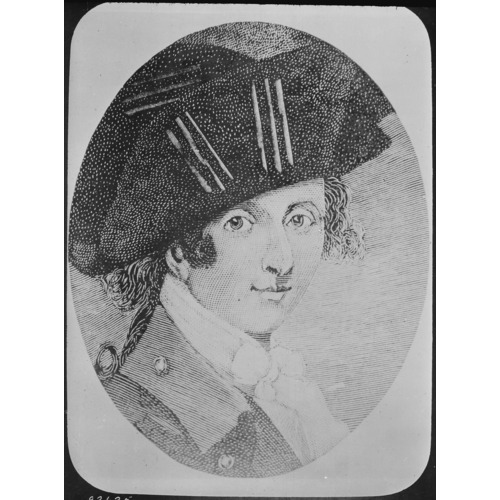
Source: Courtesy of Wikimedia Commons
ST LEGER, BARRIMORE MATTHEW (Barry), army officer; the name is variously pronounced “Sill’inger” and “Saint Leg’er”; baptized 1 May 1733, probably in County Kildare (Republic of Ireland), son of Sir John St Leger and Lavina Pennefather; m. 7 April 1773 a Miss Bayly, widow of Sir Edward Mansel, and they had at least one son; d. 1789.
Educated at Eton, then at Cambridge, where he was a fellow of Peterhouse, Barrimore Matthew St Leger joined the army in April 1756 as an ensign in the 28th Foot. He served under James Abercromby in 1757 and is supposed to have gained some experience as a bush fighter. He took part in the siege of Louisbourg, Île Royale (Cape Breton Island) in 1758 and in Wolfe*’s expedition against Quebec in 1759. St Leger was named brigade-major in July 1760, serving as a staff officer in the campaign against Montreal under James Murray. He was promoted major in the 95th Foot on 16 Sept. 1762.
By the time of the American revolution St Leger was lieutenant-colonel of the 34th Foot. He took part in the operations in 1776 that drove the Americans from Quebec and up Lake Champlain to Ticonderoga (N.Y.). When Major-General John Burgoyne proposed an expedition to take Albany (N.Y.) as part of a scheme to cut the colonies in two, he suggested that St Leger command a secondary advance from Canada through the Mohawk valley.
St Leger’s expedition left Montreal on 23 June 1777 and reached Oswego on 25 July. Advancing through the wilderness, the British and their Indian allies reached Fort Stanwix (Rome, N.Y.) on 2 August. Since the fort was too strong to be taken by assault, they besieged it. The chief action of the little campaign occurred when a force of militia under Brigadier-General Nicholas Herkimer attempted to relieve the fort. The Americans were ambushed and defeated in a hard-fought battle nearby at Oriskany on 6 August [see Kaieiñˀkwaahtoñ]. During the engagement, however, the defenders of Fort Stanwix raided and looted the weakly held British positions around the fort. The Indians eventually withdrew, and St Leger, tricked into believing that a second American relief column was much closer than it actually was, raised the siege on 22 August and retreated the way he had come.
Back in Canada, he attempted once more to join Burgoyne but got no farther than Ticonderoga before Burgoyne surrendered at Saratoga (Schuylerville). For the remainder of the war St Leger commanded a force of rangers based in Montreal. He was promoted colonel in 1780, and in 1781 he led two unsuccessful enterprises. The first was an attempt to capture Philip John Schuyler, a retired American general and a leading New Yorker in the revolutionary cause. The second involved a meeting at Ticonderoga with representatives of some dissatisfied Vermonters led by Ethan Allen to discuss the possibility of Vermont’s returning its allegiance to the crown. The plot was uncovered in Vermont, however, and before anything could be accomplished Lieutenant-General Charles Cornwallis surrendered at Yorktown, Virginia, effectively ending the war.
After the revolution St Leger continued to serve in Canada. Promoted brigadier-general, he was for a short time commander of the British troops after Frederick Haldimand’s departure in November 1784. He suffered from ill health, however, and in spite of not receiving any orders for his relief from the home government, he gave up his command to Henry Hope late in 1785. After that year his name disappears from the Army list.
Authorities have generally considered St Leger a capable soldier in frontier warfare, but his record indicates that he was a better follower than a leader; G. F. G. Stanley concludes only a little too harshly that “as a commander St. Leger was neither inspiring or inspired.” His chief fault in his one independent campaign was that he underestimated his opponent, but the same mistake was made by the entire British army and government.
“Colonel St. Leger’s account of occurrences at Fort Stanwix” was published as app.XIII to [John Burgoyne], A state of the expedition from Canada . . . (London, 1780; repr. New York, 1969). Boatner, Encyclopedia of American revolution. D. B. Chidsey, The war in the north; an informal history of the American revolution in and near Canada (New York, 1967). Duncan McArthur, “Canada under the Quebec Act,” Canada and its provinces (Shortt and Doughty), III, 107–38. J. N. McIlwraith, Sir Frederick Haldimand (London and Toronto, 1926), 211–12, 295–96. Hoffman Nickerson, The turning point of the revolution, or Burgoyne in America (2v., Boston and New York, 1928; repr. Port Washington, N.Y., 1967). Stanley, Canada’s soldiers. W. L. Stone, The campaign of Lieut. Gen. John Burgoyne and the expedition of Lieut. Col. Barry St. Leger (Albany, N.Y., 1877; repr. New York, 1970). C. [L.] Ward, The war of the revolution, ed. J. R. Alden (2v., New York, 1952).
Cite This Article
James Stokesbury, “ST LEGER, BARRIMORE MATTHEW (Barry),” in Dictionary of Canadian Biography, vol. 4, University of Toronto/Université Laval, 2003–, accessed December 4, 2025, https://www.biographi.ca/en/bio/st_leger_barrimore_matthew_4E.html.
The citation above shows the format for footnotes and endnotes according to the Chicago manual of style (16th edition). Information to be used in other citation formats:
| Permalink: | https://www.biographi.ca/en/bio/st_leger_barrimore_matthew_4E.html |
| Author of Article: | James Stokesbury |
| Title of Article: | ST LEGER, BARRIMORE MATTHEW (Barry) |
| Publication Name: | Dictionary of Canadian Biography, vol. 4 |
| Publisher: | University of Toronto/Université Laval |
| Year of publication: | 1979 |
| Year of revision: | 1979 |
| Access Date: | December 4, 2025 |



